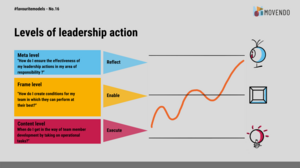#favouritemodel No.16 - Levels of leadership action

Especially in direct dialogue, I repeatedly meet managers who describe the balancing act between taking on operational (specialist) tasks and their simultaneous responsibility for the well-established framework of the team as the real challenge of their role.
An instrument that I find very helpful is then the reflection on the different levels at which I can and should be effective as a leader. While I can act at several levels within your leadership, it is important to take a conscious decision at what level I bring the most value based on the given situation.
Rolling up sleeves and pitching in.
In the role as a leader, I can act and be effective at different levels. On the one hand, there is the operational level, where I make a concrete contribution to ensuring that tasks are processed and problems are solved. Here, I roll up my sleeves and lend a hand. This is very much appreciated by some employees and also by some leaders. After all, technical experts have often become managers. As a result, many expectation patterns have become established that the leader must be at least at eye level with the team in terms of expertise, and admittedly, some operational tasks are simply fun - especially if they suit me.
Design framework conditions.
However, my activities as a leader must be different from those of my employees. Otherwise, I would literally be taking away their space and thus also the room for development. So, if I am not operationally active as a leader, what am I taking on?
In #favouritemodel 1, I described that leadership means creating a framework in which others can perform. As a leader, I largely operate at this framework level. This is exactly where the difference lies and also the much greater value contribution that I can make as a leader. Instead of working operationally, I create the general conditions that the team needs, work out goals, remove obstacles, create networks, ensure rules of the game and make sure that conflicts are resolved. Thus, my contribution to performance can certainly lie in thinking and reflecting. It is important that I make this value contribution and its relevance in the overall performance context clear to myself and others. Particularly in the recognition of leadership performance, some organizations have a considerable need for development and thus it is also difficult for individuals to derive personal satisfaction from the leadership contribution. But this is precisely what is crucial for leaders to develop their own potential and not stand in the way of employees' development.
Reflect on one's own leadership actions.
The third level of action is the meta or helicopter level. We have already described the helicopter perspective in detail in #favouritemodel 4. Leading at the meta-level means reflecting regularly:
- What does my leadership need next in the context of my team?
- What strategic impulses do we need?
- How do I need to lead differently?
- What other culture do we need to achieve our goals and maintain our trusting relationships?
For the reflection of these and similar questions, I regularly set a fixed block in my calendar.
Certainly, leaders at all three levels add value, and that's why it makes little sense to say that leaders should never work at the operational level. At the same time, the operational level has a certain magnetic pull, and that's why it's important to consciously decide when I move to this level. Simply due to the fact that the operational level is usually occupied by others already, focusing on the framework and meta levels adds significantly more value. In each case, it is important to consciously decide at which level I act as a leader and thus create the greatest added value in the respective situation.
How does my #favouritemodel help you?
I always have the image of the three different perspectives in mind and it helps me a lot to decide where to focus myself and my performance. I don't always stay at one level, but I consciously decide when I will act operationally and have developed clear criteria for this.
- What criteria help you in deciding for the operational level?
Leadership offers added value, and in many cases it is only through leadership that the performance of others becomes possible. In the first step, it is important for me to recognize the contribution I make when I lead and to derive self-worth and recognition from this. In the second step, it is sometimes important to ensure within one's own environment that precisely this performance is valued and that it is not judged by operational expectations.
- How do you ensure that you value your own leadership performance and that leadership itself is acknowledged in your environment?
Regular reflection on one's own leadership is an essential added value. Especially when everyone else is drifting toward the operational level, it is crucial to regularly staff this important level as well.
- How do you regularly create time to reflect on your leadership and the needs of your team?











